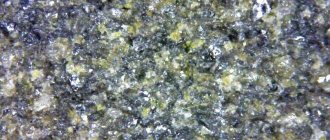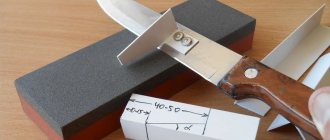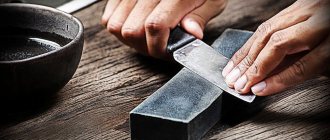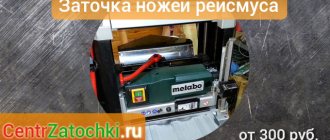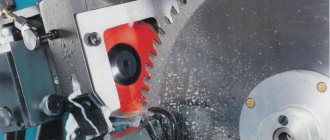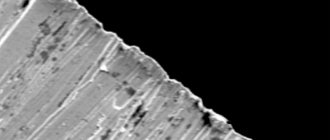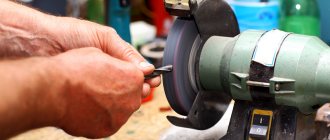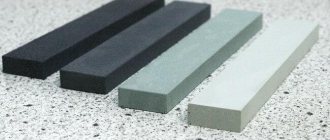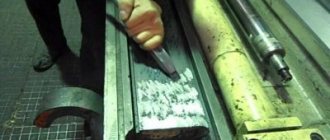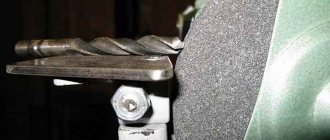Do-it-yourself knife sharpening device - drawings, varieties
In order for the blade edge to be processed evenly, several conditions are necessary:
- Fixation of the blade is both reliable and without excessive load. Metal should not be damaged in a vice
- Setting a specific angle for the bar. When moving along the edge of the knife, the angle should not change
- Possibility to set different sharpening angles. You can process a variety of tools, and some types of knives have a stepped structure.
Device for linear sharpening with a whetstone
For production you will need:
- Plywood or laminated chipboard
- Steel stud with thread along the entire length, diameter 6-8 mm
- A block of textolite or ebonite. Can be replaced with hard wood - beech, oak
- Aluminum plate 3-5 mm thick
- Fasteners - bolts, nuts (preferably wing nuts)
- Neodymium magnet from an old computer HDD.
bed
We assemble a frame from plywood, resting on legs at an angle of 15°-20°. We screw a 30-40 cm long pin into the part below. For strength, you can secure the thread with glue or sealant.
We fix an aluminum plate in the middle of the working surface. First we make a groove in it, along the diameter of the fixing bolt. Aluminum is needed so as not to damage the steel blade of the knife.
Lever for attaching the knife
- We make a lever to secure the emery. It is assembled from the remaining part of the hairpin. We cut out the bar holders from two textolite bars. On one side the stop is secured with a nut.
- It is more convenient to make a spring-loaded block on the side of the handle - for quickly changing the sandpaper.
- We use homemade bars as the main element - we glue sandpaper with different grain sizes onto an aluminum plate. Such devices are easily fixed in the lever.
A special feature of the design is a hinge with two degrees of freedom. It is assembled from two identical PCB bars. One is screwed onto a vertical pin, and serves both as a horizontal rotary axis and as an adjuster for the height of the lever support (this is how the sharpening angle is set).
Assembly of all elements
The second block, with a horizontal hole for the lever, is screwed to the first. This ensures free movement of the lever vertically.
The knife can be clamped using a plate, or mounted on a neodymium magnet. When removing the first layer with coarse sandpaper, the blade should be firmly fixed.
For finishing, you can install the blade on a magnet and sharpen it with little effort. The magnet horseshoe should be recessed flush with the table top and glued with epoxy glue.
The homemade knife sharpening device is ready. We set the required angle of attack and sharpen the edge with smooth movements along the blade.
Do-it-yourself knife sharpener - video with explanations and manufacturing example
Sharpener LM
If in the future you plan to do professional sharpening of tools in large quantities, then you can make a sharpener called: Lansky-Metabo. Drawings of a device for sharpening knives with your own hands look like this:
If the product is clamped in the clamps with the root part, the sharpening angle will be greatest. A knife with this angle can be used as a “cleaver” and for processing hard wood. You can also easily sharpen knives using a jointer. Knife clamps can be made from angle iron or wood. The disadvantage of this design is the complexity of assembly and the large number of parts.
Device for sharpening knives on an electric sharpener
Electric emery not only speeds up work, but also allows you to obtain a high-quality concave blade edge profile. This is the so-called dolovaya sharpening. It will not be possible to obtain such a shape on a linear block, so these two devices do not replace, but complement each other.
Metal stop with fixation
Due to friction, the metal on the tip heats up, and hardening occurs. The steel loses its hardness and wears off with ragged edges. Another problem is that a “released” knife quickly loses its sharpness. Therefore, you should work with an electric sharpener carefully. Apply the blade for a short time and take breaks to cool down.
In this mode it is difficult to maintain a constant angle, so fixing the knife is mandatory.
The design is quite simple - along the axis of rotation of the emery there is a guide along which the carriage with the knife moves. The angle is maintained mechanically, and the force is determined by the operator.
Second device, block stop
The device is easy to make with your own hands - and it is not necessary to perform precise work on processing metal parts. The guide is literally made from the base material.
On the workbench, next to the sharpener, guides are attached, with the help of which you can change the distance from the knife stop to the rotating circle. This distance determines the sharpening angle. The vertical rod must have free movement up and down with a strong position fixation.
The knife is held horizontally, pressing against the stop. The force of contact with the emery is adjusted directly during sharpening. Processing occurs symmetrically, you simply change the side of the knife and sharpen at the same angle.
This method is only suitable for processing classic knives. Kitchen, hunting, tourist. The cutting planes of other tools require a different approach.
Lansky Deluxe System sharpening set
One of the most famous sharpening systems, which is very popular all over the world! A high-quality, simple and convenient set for sharpeners of any level. The set includes a special clamp, which is used to sharpen the blade at a certain angle. Special sharpening oil will not only achieve better results, but will also increase the life of the sharpening stone. The most important thing in the set is five sharpening stones of varying degrees of grit and guides for them. The handles have different colors depending on the grain size of the stone.
The Lansky Deluxe System set is focused on the care of all smoothly sharpened blades and is suitable for any knives, as well as other cutting tools. The simplicity and convenience of the system allow it to be used regardless of sharpening skills, so this sharpener often becomes an object of imitation. An ideal option in terms of price-quality and the undisputed leader in its class.
Devices for sharpening knives and tools
A specialized sandpaper with an end working surface is used.
The guide for the carriage is located at the bottom, away from the axis of rotation. It is in this part of the disk that the abrasive works most effectively. The guide with the cutting element is moved manually, the pressure is provided by the knife’s own weight.
Drawings of all structural elements are presented in the illustration.
Homemade device for sharpening knives and cutting edges of tools
This machine was used almost 100 years ago, and the technology has not changed since then. Simplicity of execution allows you to repeat the device in a home workshop. Any materials - metal, plastic, wood.
Instead of using the cutting elements of a jointer, you can sharpen the knives of an ice ax for winter fishing. Only the angle is shallower. The scissor attachment works in the same way. The design (like the emery wheel) is significantly smaller in size.
How to sharpen chisels
You can also use an electric sander and a locking carriage to sharpen chisels and plane knives. However, these tools are compact and can be handled by a mechanical tool.
Read also: Is it possible to drill a concrete wall with a screwdriver?
There are two equivalent methods - along the edge and across. The quality of processing is approximately the same, so it is impossible to give preference to a specific device. The factory product involves transverse editing of the blade.
By analogy, we make a carriage from thick plywood. We use any rollers as guides, preferably more than two. By moving the machine along the sandpaper, you can give the tip of the chisel an ideal shape.
If you don't need serious sharpening, a simpler device will do just fine for minor adjustments. Attach a block with the required angle of inclination to the chisels. Place sandpaper and a piece of glass nearby. Apply soap solution to the glass.
The effectiveness of the device will pleasantly surprise you.
And for transverse sharpening, you can make an equally simple device. The guide is also a support. The blade is mounted vertically on the moving part. The only drawback is that the angle is fixed and is determined during manufacture.
True, unlike a knife, deviation from the ideal is not so critical.
The same device is suitable for sharpening plane knives. Just because of the width of the blade, the process is quite labor-intensive. Therefore, you can use an electric sander with an end working surface.
The emphasis is made of a wooden block. All you need to do is change the angle. The clamp is provided by the operator, and semicircular sharpening can be performed - carpenters will appreciate this option.
Of course, the same device is convenient for tidying up the edge of a chisel. Given the high performance, you will restore the tool even after serious nicks.
Homemade device for sharpening knives and tools from a sharpening machine
When you again manually rub a knife on an old whetstone, remember this article and create a homemade sharpening installation for your home workshop.
Everyone knows that working with a dull knife is not only difficult, but also dangerous. Due to the slowdown in the work process, tension in the muscles increases and the blade, just like that, will come off, causing serious injury. Alternatively, you can use the services of a workshop, but this will take some time, which is often not enough and will require financial costs. But if you have a knife sharpening machine at home, the process will speed up significantly.
10 devices for sharpening tools, knives, drills, chainsaw chains
A good owner should always have sharpened tools at hand - be it a knife, axe, pruning shears, shovel or chainsaw chain. And here you can’t do without a good sharpener. We have collected 10 sharpening devices that will definitely come in handy around the house.
For chainsaws
1. The Power Sharp device allows you to sharpen the chain in 4 seconds without removing it from the bar
Oregon specialists decided to help all owners of chainsaws and released a unique Power Sharp system, which allows you to sharpen the tool quickly and without much effort.
Their development, which includes a saw bar, chain and sharpening device, is called Power Sharp. The system is compatible with most saws of various brands, and its innovation lies in the fact that for sharpening it is not necessary to remove the chain from the bar.
The sharpening device is a plastic box, inside of which an arc-shaped sharpening stone is installed. You just need to place the end of the saw inside the Power Sharp, close the lid with a lock, rest the tool against the log and turn it on at full speed. After just 4 seconds the chain will be sharpened.
The four components of the system are sold in two packages: a tire plus a sharpening device (about 2,500 rubles) and a chain plus an abrasive stone (1,500-2,200 rubles). Thus, both sets are needed to sharpen the saw.
2. Chainsaw Sharpener Cordless File
Sharpenes saw teeth using saw stones, but does it quickly, accurately and easily. The compact (19.5 × 7.5 cm) manual sharpener is powered from a car cigarette lighter or from a regular battery (the kit includes a 1.75 m cable with clamp terminals). The device is suitable for most types of chain saws, does not require preliminary removal of the chain and works with each tooth individually.
The file comes with three cylindrical sharpening stones with a diameter of 4, 4.8 and 5.5 mm, which simply need to be inserted into the chuck.
A special metal bar allows you to hold the tool correctly while sharpening the chain and, accordingly, carefully process the teeth, and also protects the master from sparks bouncing off during work.
Price: 2069 rub.
3. Handheld Chainsaw Sharpener
A portable mechanical sharpener with a cutter made of tungsten carbide hard alloy allows you to sharpen your chainsaw manually in any convenient place. It works with each tooth individually and, thanks to precise adjustment, ensures stable sharpening quality: the same cutting angles and the length of all teeth without burrs.
The Chainsaw Sharpener comes in a durable case with shoulder strap and all the necessary accessories, including 30° bevel bushings and your choice of one cutter in any diameter.
Price: 8750 rub.
4. Chain Sharp CS-X device for manual sharpening of chain saws
A special mechanical device for sharpening a chain saw, created by the German company PFERD, is essentially also a file, but due to its well-thought-out design and optimized shape, it greatly simplifies the process.
The device consists of three files (flat and two round) and limiters, which are responsible for the accuracy and stable quality of sharpening. Moreover, the processing of the teeth and the adjustment of the cutting of files occurs simultaneously, which reduces the duration of the procedure.
The special design of Chain Sharp CS-X sets the correct sharpening angle and makes it easy for even inexperienced users to cope with the task. When working with this sharpener, you no longer need to control every movement and use additional tools. In addition, you can process left and right teeth without reconfiguring the device: just turn it over to the other side.
The device is available in four modifications so that you can choose the appropriate option depending on the chain pitch. And if necessary, the files can be easily removed by opening the side cover and replaced with others.
Price: about 3,000 rubles.
Sharpeners for knives, scissors, axes and other tools
5. Ken Onion Benchtop Angle Set Knife Sharpener
A mechanical sharpener will quickly restore the functionality of various cutting objects - scissors, kitchen or camping knives, pruning shears, chisels, and an axe.
This benchtop tool was designed in collaboration with legendary knife maker Ken Onion. The plastic case measuring 76 × 247 × 51 mm contains two triangular abrasive rods, each 15 cm long, with single-crystal diamond plates of different grain sizes. To sharpen the tool, they are unfolded and installed at an angle to each other. At the same time, the case serves as a stand that reliably holds the rods in a vertical position.
The sharpening angle can be adjusted from 15° to 25°. The abrasive rods, in turn, can be rotated 360°, setting the stone required at the moment into the working position: coarse, medium or fine grain.
Price: 6420 rub.
6. APEX EDGE PRO 3 sharpener
Specialists from the Ruixin factory decided to once again improve their invention - the APEX sharpener, designed for professional sharpening of knives, scissors and tool blades. The previous two generations of this device, in particular, had plastic elements that broke quite quickly. In the new APEX EDGE PRO 3 model, the sharpener is made entirely of metal, increasing its reliability, and also significantly improved the design, making it more convenient and functional.
The main feature of the new product is the mechanism for fixing sharpened blades, which was previously absent from APEX. The user no longer needs to hold the blade or purchase an additional neodymium magnet to secure it.
The presence of a locking mechanism increased the sharpening quality and functionality of the device, allowing it to sharpen the blades of planes and chisels. And since the far edge of the working part can now be fixed at different heights, it is now possible to adjust the sharpening angle from 5 to 30º.
APEX EDGE PRO 3, as in previous models, comes with 4 sharpening stones with grain sizes of 120, 320, 600 and 1500 microns, but thanks to a special spring, you can quickly replace them in the new sharpener.
Price: 2190 rub.
7. Sharpal 103N All-In-1 Sharpener
A universal manual sharpener is suitable for knives, scissors, scythes, axes, pruners, loppers, hoes, shovels, scrapers, etc. For this purpose, its body has 3 slots for sharpening with a given optimal angle, carbide and ceramic rods.
The Sharpal 103N All-In-1 design allows you to sharpen tools either hanging or while holding them in a vice. The device itself can be hung from a special hole or installed with a flat base on the countertop. The large, anatomically shaped handle with a rubberized pad provides a secure grip and is comfortable when working with gloves. Thanks to carefully thought-out ergonomics, the sharpener is safe to use.
Price: about 2000 rub.
8. Universal sharpener SKU 50969
Works with any types of knives and a variety of garden tools - axes, shovels, pruners, hedge trimmers, etc. It is noteworthy that the model is cordless and operates from a built-in battery - a lithium battery (7.2 V, 1.5 A/h), so Sharpening can be done in any convenient place. And thanks to the modern fast charging technology used in the device, the battery is charged in less than an hour.
An abrasive belt is attached to the rotating head of the sharpener, so you don’t have to apply any effort when working.
The model comes with three types of sanding belts: coarse-grained (P80), medium-grained (P240) and fine-grained (P600). The ability to change the belt for preliminary and final sharpening allows you to tidy up even very dull and damaged blades. In addition, the device has a special groove with ceramic abrasives for sharpening knives and tools with thin blades, as well as a function for adjusting the guides according to the sharpening angle (15, 20, 25 and 30°).
SKU 50969 has built-in overheating protection: at a critical moment, it stops the movement of the rotating head, thereby preserving the “life” of the blade and the sharpener itself.
Price: 5600 rub.
Drill or screwdriver sharpeners for quick sharpening of drill bits
9. Compact sharpener from Mayitr
It will help you quickly sharpen drills without going to a workshop, thereby saving time and money.
The product, measuring 18 × 4 × 3 cm, is convenient to carry and store in a tool box. It is a kind of attachment with a sharpening stone driven by a drill or screwdriver.
The design of the device is very simple. A cylindrical grinding stone is attached using a spring clamp to the working part of the nozzle, and the drill to be sharpened is placed in a special groove provided in it. When the drill or screwdriver is turned on, the stone begins to rotate and sharpens the drill bit.
Price: 470 rub.
10. Multi-Sharp attachment ATT2001
The special attachment is a kind of alternative to a sharpening machine, only in this case the drill itself is used instead of an electric motor. The attachment can be attached to the tool chuck or mounted on a workbench for constant use.
The attachment contains two cylindrical abrasives that will restore the performance of not only twist drills, but also pen drills, as well as carbide tips.
The Multi-Sharp ATT2001 comes with a special movable guide designed for setting the sharpening angle. The master only needs to control the force with which the drill must be pressed against the abrasive. In addition, the package with the attachment contains several trays and stops for sharpening other tools - cutters, screwdrivers, chisels, etc.
Price: 1950 rub.
Why do knives lose their sharpness?
Cutting products, no matter what their quality, become dull over time. This occurs due to the blades changing shape as a result of the loss of microscopic particles of the material from which the blade is made when interacting with the object being cut. In addition, under pressure, which is sometimes quite strong, the cutting edge is deformed as a result of deflection in any direction.
In addition, the cutting direction is not always maintained, which causes curvature of the very edge of the knife surface and makes it difficult to pass along the cut line. This is especially evident in blades made from low-grade raw materials.
Many people think that knives become dull much faster in hot water. This assumption is partly correct, although it is not decisive. Such tap liquid is saturated with salts and metals much more strongly than cold liquid, therefore their interaction with the cutting surface has a negative, although not decisive, effect.
What knives can be sharpened?
Not all blades can be sharpened at home, but only blades made from not very hard materials. So, if the hardness of the material from which the blade is made exceeds 55 units on the Rockwell scale (55HRC), then it will not be possible to sharpen it with any tool available to most people. But most of the knives produced now are made of fairly soft materials and such knives are not at all difficult to sharpen.
True, their service life between sharpenings is not long at all.
But no matter what metal the knife is made of, sooner or later it will still have to be sharpened. The only exceptions to this rule are knives with replaceable blades and ceramic knives that cannot be sharpened at all. Thus, a knife sharpening device must be universal, that is, it must be able to sharpen various blades with different sharpening angles.
Note!
Do-it-yourself winch: classification, manufacturing materials, description of work stages + instructions for DIY constructionDo-it-yourself clamp - step-by-step production and description of options for using a clamp
DIY knife | A step-by-step description of how and from what materials to make a homemade knife
Therefore, when creating a device for sharpening knives, it is necessary to provide for the possibility of sharpening blades with different angles, and this is the most difficult task both at the design stage and during the manufacture of such a device.
How to sharpen a blade
Household cutting accessories are made from special and powder grades of steel. The structure of their sharpening resembles the teeth of rodents: the further from the edge, the less hardness of the cutting layer.
Therefore, ideal manual sharpening of knives occurs according to the push-pull principle or the push-pull method (from English push-pull sharpening):
- The cutting blade is first pushed away from itself with a scraping motion, with a slight turn to the side.
- Further, without lifting the blade from the sharpener, the movement occurs towards itself, with a turn in the opposite direction.
- This continues until sharpening is complete, with a gradual weakening of the pressure.
This technique requires certain skills from the sharpener, as well as careful treatment of the blade itself. This method requires:
- Clearly maintain the tilt of the knife, gradually changing it depending on the curvature of the knife.
- The contact spot of the blade must coincide with the tangent line of the whetstone and be perpendicular to its longitudinal axis.
- The pressure on the surface must be changed smoothly.
It is difficult to carry out the process, observing all the rules when moving the blade in both directions, and an incorrect result renders the blade unusable. To relieve the sharpener from constantly monitoring the sharpening process, they came up with machines for sharpening knives.
Necessary conditions for sharpening
Maintaining the angle between the edges of the blade when sharpening it is the key to effective use and long service life of household accessories. It must be restored in accordance with technological standards, then there will be no problems with cutting. Knives for various purposes have their own sharpening angle:
- The razor and scalpel are sharpened at an angle of 10-15 degrees.
- Bread, vegetable and fruit knives - 15-20 degrees.
- General purpose cutting objects - 30−25 degrees.
- Knives of hunters and tourists - 25-30 degrees.
- Blades made of special steels for working with particularly hard materials - 30-40 degrees.
It is difficult to maintain the required parameters without using a special device. Therefore, there are many ways to make them yourself. It’s easy to do, and you won’t have to spend much time at all.
Sharpener parts
No matter how many such devices are invented, they have the same common features. The main and constant parts of any sharpening tool are ;
- Abrasive component.
- The thrust part.
All sharpening components that are used at home and at work are presented in stores. Here are the main ones:
- Ceramic bars.
- A natural stone.
- Diamond sharpener.
- Japanese water devices.
The most popular and affordable abrasive is the ceramic stone, which is most common in retail outlets. Most often this is an ordinary boat for rough sharpening the blade. There are double-sided bars, which are preferable for household use. This is an inexpensive device, the replacement of which as it wears out will not bring large financial costs.
Grinding using diamond stones is more complex and expensive. In addition to the high price, such sharpeners quickly wear out the working part of the blade.
The best whetstones for sharpening are natural and Japanese stones. However, their price is very high and they are not produced in our country.
Homemade sharpening device
In order to make a knife sharpening machine with your own hands, the first thing you need to do is find a suitable drawing. There are many modifications for its production.
The easiest way
This option does not require special skill or the use of expensive components. To make it you will need:
- Wooden corners with a side of 20-30 centimeters: 2 pieces.
- Screws with nuts in the amount of 10 pieces.
- Protractor for precise angle setting.
- In addition, you will need a drill and drill bits.
To make it, you need to mark the corners and drill 3-4 holes at identical points. Place a block between them at the desired angle and secure with bolts.
To sharpen a knife or scissors, you simply need to run the blade along the surface of the block, holding it strictly vertically.
To change the sharpening angle, you simply need to loosen the fasteners and modify the position of the abrasive part. In order not to pick up a protractor every time, it is recommended to put marks on the base, marking the main positions of the block.
The ability to change the sharpening angle is the only advantage of such a manual knife sharpening machine. In terms of convenience, it is not far from an ordinary bar.
Sharpening machine is more complicated
For more comfortable work, a more complex device will be required . To make it, you need the following parts and tools:
- Plywood, laminate or chipboard.
- A meter strip with a thickness and height of 2-4 centimeters. You can take two pieces, one longer, the other shorter.
- Bolts with nuts - 2 pieces.
- Hacksaw and marking tool.
First you need to make a knife holder. To do this, from a piece of plywood, or whatever is available, you need to cut a rectangle measuring 10 by 4 centimeters (dimensions are approximate). The wide part must be ground at an acute angle to prevent the block from touching its edge when sharpening.
For the base, you need to cut out another piece of plywood with dimensions of 30 by 25 centimeters.
Read also: Remez compressor pressure switch
At a distance of 1-2 centimeters from its edge, a holder is placed with the cut outward and secured with bolts. The blade will be located between them.
The next stage is the manufacture of a stand from a long rail, along which the bar moves at a fixed angle. It needs to be installed vertically on the base and the angle measured in relation to the holder. The upper part is cut at the appropriate angle. The second post is cut in a similar way and connected with the rest of the rail on top, so that the result is a U-shaped part.
The assembled structure is attached to the base on the side opposite to the holder. This can be done using screws or wood glue.
All that remains is to make the base for the abrasive part. To do this, stick sandpaper with a grit from P600 to P2000 onto a short strip.
To work with such a sharpener, it is better to place it on the edge of the table in such a way that the protruding bolts connecting the base and the blade holder rest against it, thus preventing the device from sliding.
Electrical devices
These are the most versatile devices. When using them, the sharpening angle is selected independently; just select the desired position of the blade. The main part of an electric knife sharpening machine is sanding wheels with different grain sizes and angles. The discs are driven by an electric motor. Therefore, energy dependence is a disadvantage, although not the main one in the use of such equipment.
The main disadvantage of this method of sharpening is the inability to visually control the process, since to ensure safety during sharpening, all rotating mechanisms are completely closed.
It is impossible to make such a device at home. Therefore, it is simpler: a disk or belt abrasive is attached to a conventional electric motor. When using a round stone, a stop is installed with the ability to change the inclination of the blade. Any cutting tools can be restored on such a machine.
Preparing for sharpening. What needs to be done before this?
Upon closer inspection, the knife blade looks like a saw, and the more often the teeth are located in it and the smoother the transition between them, the easier it is to use the tool. A dull knife loses these teeth, they wear out, bend and crumble. There are many ways to sharpen a knife using mechanical and electric sharpeners, as well as special machines with sharpening wheels. But sharpeners do not give an ideal result, and easel sharpening requires considerable knowledge and skills. Therefore, we will look at how to properly sharpen knives with a whetstone in a step-by-step guide for doing it yourself at home. This method will give you two main advantages: considerable money savings and excellent results.
1
4
The first thing to do is determine the extent of damage to the blade. It's very easy to do. Place it at an angle to a beam of bright light. This method instantly identifies all the chips and irregularities that you need to eliminate. They will appear as dots or lines on the blade. If the boundary between the planes is uniform, sharply defined, without transitions, then the instrument is in excellent condition. After this, the knife must be washed in water with added soap. This is done to facilitate subsequent work. It will become easier for the knife to slide along the sharpening stone, and it will be easier for you to maintain the required angle between the planes of the blade and the blade.
By pointing the knife blade at the sunlight, we can see any flaws in the metal
After sharpening the knife must be cleaned with soap.
Errors during manual work
Not every family has professional specialists to do this kind of work. In order to properly sharpen a blade, you need to avoid typical mistakes that beginners make:
- The most common drawback of unprofessional sharpening is the leaving of small burrs on the edge of the blade. During the first use, they fall off and the blade returns to its original condition. To prevent this from happening, a thorough inspection of the tool after sharpening is necessary, including the use of a magnifying glass.
- You cannot sharpen a blade if there is dirt or grease on it, as well as remaining particles of the previous, larger abrasive, if we are talking about finishing sharpening the blade.
- Don't press the blade too hard. The severity depends largely on the accuracy of the event and its duration. Using excessive force can break the blade.
- Adhere to the specified sharpening angle.
Brief overview of models
In addition to homemade sharpening devices, there are many similar devices in factory production. The most popular of them are:
- Lansky knife priced from 65 to 80 dollars with a movable bar and angle adjustment between 17-30 degrees.
- For $40 you can purchase a SpitJack machine.
- You can also purchase Aligner AKEFC for $90.
- The Ganzo Touch Pro model costs $90-100.
- The most expensive sharpener is the Apex 4 Kit Edge, which is suitable, in addition to sharpening household cutting objects, for sharpening hunting knives. It will cost 200-220 $. Its Korean copy Ruixin is estimated at $30-40.
These are the most well-known brand names, and cheaper and simpler devices can be purchased for 20-30 dollars.
Electrical installations are much more convenient, but also more expensive. Small Chief's Choice devices of various modifications cost from 120 to 250-300 dollars. Their sharpening angle is fixed, 20 degrees, and is used for sharpening flat knives in cafes and restaurants.
The same company offers a large number of mechanical devices, which are an abrasive bar in a housing installed at a certain angle. For them you will have to pay from 40 to 50 dollars.
A DIY knife sharpener will be very useful in the household.
With the help of fairly simple devices, you can carefully and safely sharpen cutting tools, which is simply necessary in the kitchen, fishermen and hunters, and in the workshop.
Of course, a wide range of sharpeners are offered in stores, but homemade devices will save you from unnecessary costs.
Making a machine for sharpening knives with your own hands
Although nowadays you can easily buy the necessary tools and equipment designed for sharpening knives and other cutting tools, nevertheless, handicraft citizens continue to make knifes with their own hands in their free time. When making a knife sharpener with your own hands, you need to decide on its type (manual or electric) and the type of abrasive materials used (block, wheel, sanding belt), as well as the available materials that will be used to make the body of the assembled device and its frame. Let's consider the option of a manual sharpener using an abrasive stone and plywood as a structure frame. The appearance of the assembled device is shown in the following figure.
Manual sharpening machine made from scrap materials
To make such a machine you will need the following materials and tools:
- sheet plywood 10–12 mm thick or chipboard, can be from old cabinet furniture;
- metal pin with a diameter of 10–12 mm;
- sheet steel 1 mm thick;
- fastening screws or nuts with washer corresponding to the diameter of the stud used;
- a block 25–30 mm thick - for making stops for the abrasive stone;
- profile metal pipe with a cross-section corresponding to the dimensions of the bar;
- abrasive block;
- hacksaw for metal and wood or their electric analogues (jigsaw, grinder);
- electric drill or screwdriver.
Manufacturing work is carried out as follows.
| Illustration | Description of action |
| Making the machine base and tool rests | |
| The base of the machine is made from plywood or chipboard. | |
| Holes are drilled in the base for attaching the adjusting pin. | |
| Hand rests are made from sheet steel. | |
| The adjustment pin and hand rests are installed on the base of the machine. | |
| Manufacturing of fixing and tilt angle controlling devices. | |
| A fixing device is being manufactured. | |
| The fixing device is installed on the prepared base. | |
| A device that regulates the angle of inclination is manufactured and installed. | |
| Manufacturing of the carriage and base for replacement bars. | |
| A carriage for abrasive bars is made from another metal pin and wooden blocks. | |
| The base for placing the bars is cut out of a profile metal pipe, and the final assembly of the machine is performed. | |
The market for goods intended for sharpening knives and other cutting tools offers a wide selection of models that differ in design and purpose, type of use and equipment, which allows you to select a device in accordance with the selection criteria and financial capabilities of the user. When choosing a specific device or model of sharpening equipment, assistance will be provided by sales consultants in trade organizations, and how to use it correctly can be found on the Internet.
You can learn how to properly sharpen knives with a whetstone by watching the video below.
The need for devices and machines
A dull knife is a torment for the housewife when she slices bread, cooks food, or cuts meat. Cutting with them is not only difficult, but also dangerous, because... It is with a blunt instrument that injuries are most often caused . There is no point in proving the need for a sharp blade for a fisherman, hunter, shoemaker, etc. It is absolutely clear to everyone that a knife requires periodic sharpening. Another thing is how to provide it.
Many people use tools such as abrasive stones, sanding wheels, sandpaper, and files . Most often, abrasive or grinding stones are purchased for these purposes, and the procedure itself is carried out “by eye.” After such sharpening, the knife becomes sharp, but also dulls quite quickly.
Why is this happening? The knife blade is made of various steels, has different thicknesses and sharpening parameters. The process of high-quality sharpening should completely restore the shape of the blade, and only in this case will its sharpness meet the planned standards.
Ensuring uniform sharpening without fixing the position and guide elements is very difficult even for professionals. The task is much easier when using special devices that allow you to stabilize the processing mode (loads, directions, speed).
To mechanize rather labor-intensive work, it is better to use appropriate sharpening machines. Both devices and machines can be made with your own hands.
Types of blades and the correct sharpening angle of knives: what should it be
Knives are made from different materials, but the main ones are different types of steel. Regardless of the material or shape of the product, it will in any case need sharpening over time, because working with a blunt device poses a danger to the user. The following materials are mainly used for the production of knives:
- Carbon steel. Such products are not intended for long-term use, because they quickly corrode.
- Stainless steel. In addition to the main material, chromium, nickel and molybdenum are used for manufacturing. These knives require constant sharpening.
- High carbon stainless steel. Thanks to the presence of vanadium and cobalt in the composition, the strength of the blade increases significantly.
- Damascus steel. Expensive material used for elite hunting or collectible knives. This blade can only be sharpened by hand along the edge.
- Titanium alloy. The composition also contains a carbide additive, which is why the blade retains its sharpness for a long period. It is better to sharpen knives using a professional sharpening machine.
- Zirconium alloy. It is made by firing and pressing high-hardness mineral ceramics. No special tools are required for sharpening.
Stainless steel knives need timely sharpening
You can determine that the blade has become dull not only when working with the device, but also by eye. Proper sharpening is needed to restore the contours of the cutting edge of the blade. The main difficulty of the sharpening process is maintaining the desired angle of inclination, and special devices for the sharpening angle of the knife will help with this.
Helpful information! The smaller the sharpening angle of the blade, the easier it is to cut the required material, which is especially important when working with soft products. A knife with a small sharpening angle dulls several times faster compared to devices with a large sharpening angle.
To navigate inclination angles, standard values are mainly used. For example, an angle of 45-55° is sufficient for hairdressing scissors, and 75-85° for metal scissors. But a more delicate device, such as a surgical scalpel, requires 10-15° sharpening. The sharpening angle of a hunting knife should not exceed 25-30°.
Titanium alloy knives are recommended to be sharpened using professional tools
Basic principles of sharpening
When properly sharpening a knife, the main condition must be met - the formation of a sharp edge of the blade while maintaining its shape , which is ensured by removing the metal at a certain angle.
Turning is carried out with an abrasive material that has different grain sizes. Its choice is determined by the strength characteristics of the steel. Proper sharpening implies a certain order of work.
Sharpening angle
The effectiveness and quality of the event under consideration is limited by a fundamental parameter - the sharpening angle. Depending on their purpose, knives have the following meanings:
- Straight razors have the smallest angle – (7-11)°;
- fillet knives – (11-14)°;
- kitchen knives for most products, incl. bread, vegetables, meat, etc. – (16-21)°;
- hunting tools and knives for general technical purposes – (21-26)°;
- universal hunting knives – (21-40)°;
- a special tool that is used for cutting and chopping (for example, a machete) – (29-50)°.
The sharpening angle largely determines the thickness of the blade. At the smallest angles it should resemble a razor, and at large angles it becomes possible to manufacture especially strong, massive knives.
The main task of the device is rigid fixation of one of the elements and a clear direction of movement of the second element.
Types and choice of abrasive
To sharpen knives, you need an abrasive stone , which will ensure the necessary cutting of metal. The abrasive ability is provided by a certain surface grain size, i.e. the number of abrasive grains per unit area. According to this parameter, the following stones are distinguished:
- very coarse abrasives (international classification - extra coarse) - have a grain size of less than 260;
- coarse abrasives – 310-360;
- medium abrasives – 390-510;
- fine abrasives – 590-720. This is the main category of sharpening stones used for cutting knives;
- very fine (ultra, extra fine) or grinding abrasives. They are used for sharpening razors and fine surface finishing of knife blades.
According to the nature of their origin, abrasive stones are divided into natural or natural (corundum, slates) and artificial (ceramics, artificial diamond). In addition, rubber elements are sometimes used for fine processing. When using abrasives, their surface is moistened with water or a soap-water solution (water tool), as well as oil (oil stones).
The shape of abrasives can be round (discs) or rectangular (bars) . The most commonly used bars are bars, and they are selected so that the length significantly exceeds the length of the knife blade .
To fully sharpen the tool, it is recommended to have 2 bars of medium and fine grain. It is better to complement the set with a very small stone. The best option is to use double-sided bars, in which one side has a medium grain and the opposite has a fine grain.
Read also: How to make a laser engraver yourself
Manual sharpening procedure
Any devices are designed to facilitate work and improve its quality, and the general procedure for manual sharpening remains the same:
- The process begins with a coarse or medium-grained bar, which is laid on a plane. It is advisable to ensure its fixation.
- The knife blade is brought to the abrasive surface at an angle equal to half the sharpening angle. The main task is to ensure a constant angle throughout the event.
- With a smooth movement with light pressure, the blade moves from the beginning to the end of the block in the direction “away from you.” The edge of the bar must always be perpendicular to the direction of movement of the blade. Do not allow the blade to break off at the end of the stone.
- After reaching the edge of the bar, movement is carried out in the opposite direction, while the sharp edge must always be on the surface of the abrasive. Changing direction is achieved by turning the handle.
- The process is repeated until a burr along the entire length appears on the back of the blade tip. It should move to the opposite side when changing direction.
- Next, take a medium-grained block, but with smaller grains. Sharpening continues, but the movements are carried out initially only “from oneself” until the metal shines on one side, and then the second side is also processed.
- A fine-grained block is taken and the blade is processed until a mirror surface appears.
- If a small burr remains, sharpening is completed by using a very fine grit sanding block. Some experienced people prefer to use a leather belt . It polishes the knife blade perfectly.
Homemade devices
Home craftsmen make sharpening devices of various designs, but they all include 2 main elements - an abrasive block and a knife fastening mechanism . A ready-made abrasive block is best suited for the device, but you can also make it yourself.
To do this, sandpaper of different grain sizes is glued to glass with a thickness of at least 4 mm. The connection can be ensured with double-sided tape.
Fixed device
One of the simplest devices is made from 2 triangular-shaped wooden blocks . They are fastened together with thumbscrews. An abrasive block is clamped between the wooden elements at the desired angle. This angle is set strictly according to the protractor.
When sharpening a knife on such a device, the blade must be kept strictly vertical . Naturally, ensuring such a direction is much easier than constantly guiding the knife at an angle.
Movable structure
To improve the quality of sharpening, it is necessary to fix not only the abrasive, but also the knife. You can also make such a device yourself. It is assembled on a flat, horizontal, massive surface. The device consists of 2 parts - a rigidly fixed abrasive bar at the desired angle (similar to a fixed structure) and a trolley on wheels (rollers) with a knife fixed horizontally.
The trolley moves manually along a guide rail. The hand also ensures that the blade is lightly pressed against the abrasive surface. This ensures the desired sharpening angle and eliminates the need to provide the desired direction manually.
Changing direction can be done in different ways. The simplest one is to make a cart with wheels at the top and bottom. When the bar ends, the cart simply turns over.
Dot machine
Sharpening machines have a more complex design that allows you to change the sharpening angle. Several options for a constructive solution can be given:
- A knife is fixed on the platform with the possibility of adjustment. It is adjusted to the required angle and fixed permanently. The abrasive bar is installed on a movable rod mounted on a vertical support. It moves strictly horizontally. Sharpening is achieved by moving the abrasive relative to the knife blade .
- It is fixed on a fixed frame, but the block can be moved along the guide to set the desired sharpening angle. The knife is installed in a movable table, and is secured with a magnetic holder, which makes it possible to turn it over.
Correct sharpening of knives
There are types of knives that are impossible to sharpen yourself due to the textured blades. Also, knives made from ceramics cannot be sharpened. But, as a rule, the quality of the steel in such products is high, and they rarely become dull. There are a variety of knives of low quality, and they have to be sharpened very often. As practice shows, if the steel is of poor quality, then sharpening will solve the problem for a while, and then the blade will become dull again.
To sharpen knives you will need abrasive wheels. If it is not possible to purchase ready-made circles, you can make them yourself using wooden blocks and sandpaper of different grain sizes.
The standard sharpening angle is 20 - 30 degrees. It is quite difficult to maintain the angle during sharpening, and therefore it is necessary to make a simple knife sharpener, in which it is not necessary to maintain the optimal angle. The basic rule in this process is maintaining a precisely specified constant angle. No force required here. The main thing is that the block and blade meet at a certain angle. This is the basic rule of the sharpening technique.
DIY example
As an example, we can cite the technology of self-manufacturing of sharpening accessories - an analogue of the Lansky sharpener . It has a standard design.
The knife is fixed on a horizontal base, and its fastening is ensured by a magnet . The sanding element is located on a rod along which it can move perpendicular to the knife. The guide rod is installed in the holes of the vertical post.
These holes are drilled at an angle to the surface of the post and thus set a certain angle for the rod. Several holes are drilled vertically in the rack and by rearranging the guide you can also change the sharpening angle.
The manufacture of the device is carried out in the following order:
- On the base plate (chipboard, board, metal sheet) slats are installed , limiting the displacement of the knife in the transverse direction. One of them is mounted in slots with thumbscrews for fixing knives with different blade widths. A magnet is fixed in the center of the knife location .
- The emery block is attached to two pieces of angle, which are fastened with pins. Holes are drilled on both sides of this part for installation on the rod.
- A steel rod with a diameter of 10-15 mm is passed through the indicated holes, and a limiter to prevent the bar from falling. The other end is threaded .
- On an aluminum U-shaped profile 30-50 mm wide, 5-6 holes are drilled with a diameter 1-2 mm larger than the diameter of the rod. The holes are drilled at an angle corresponding to the sharpening angles, taking into account the height of the location on the rack.
- The rod is installed in the desired hole and secured with bolts.
This device works as follows:
- the knife is fixed on the base and attracted by a magnet;
- a block of the required grain size is installed on the sharpening element;
- the rod is fixed in the desired hole on the stand;
- by hand, the block moves along the rod, processing the blade, and the movement is carried out “from oneself” and “towards oneself”;
- with the other hand, the knife gradually moves in the longitudinal direction.
See detailed drawings, descriptions and illustrations of a knife sharpener with and without a magnetic holder in the video below:
Knife sharpeners: characteristics, types, types
- Stone. It is also a “sharpening stone” or “touchstone”. The simplest type of sharpener, used since prehistoric times: a block of abrasive material, along which a knife applied at the desired angle is passed during the sharpening process. Modern stone sharpeners can be equipped with various additional devices: stands, protective covers for storage and transportation, compartments for auxiliary accessories, etc. However, sharpening on such devices is carried out strictly by hand, and the angle usually also has to be controlled “by eye”. This, on the one hand, requires certain skills, on the other hand, it allows you to choose the angle at your discretion, which can be especially useful for some non-standard types of sharpening. In addition, due to their simplicity, stones are inexpensive, and due to their large sizes, they last quite a long time. — Hand sharpener. Devices for sharpening knives, held in the hands while working (however, there are models with stands that allow you to place them on a table or other suitable surface). A distinctive feature of many manual sharpeners is the characteristic groove into which the knife is inserted when sharpening. Inside the groove there is a pair of abrasive pads located at an angle optimal for sharpening. Thus, the user only needs to move the knife in the groove several times, holding the blade vertically - the desired angle...of processing will be provided by the design of the sharpener itself. Many models of this type have several grooves that differ in roughness and other processing features. There are other options - for example, with the Lansky sharpening system (see “System”). Be that as it may, a manual sharpener will be the best choice for infrequent household use - for example, periodic sharpening of kitchen knives.
— Pocket sharpener. In accordance with the name, pocket sharpeners are small in size, allowing you to easily carry such a product with you. Some of them are also equipped with additional devices for ease of carrying - for example, a chain for hanging as a keychain. But the design of pocket models may be different. For example, some of them have grooves for sharpening, similar to manual sharpeners (see above); others open like a butterfly knife, only instead of a blade, a small sharpening stone comes out of the handle; still others have a “dog bone” type design, in the form of a rod made of abrasive material with protective and decorative linings at the ends, etc. In any case, a pocket model will be indispensable if you often have to be away from home, and you need to have a sharpener at hand - for example, on a camping trip or fishing (many models are suitable for sharpening hooks, see below). Of course, the capabilities of such products are noticeably more modest than those of larger analogues, and the quality of work is lower; but for express sharpening in the field this is quite enough.
- Machine. The most advanced type of modern sharpeners: multifunctional designs that allow you to configure many additional sharpening parameters and/or significantly speed up the process. However, the main distinguishing feature of the machine is the presence of a base for installation on a horizontal surface - such devices are not suitable for holding in the hands. Note that the machines include both mechanical structures with sharpening systems like Lansky or Apex (see “System”), and units with electric drive (see ibid.). Machines, as a rule, use replaceable sharpening stones, have adjustable sharpening angles, and sometimes have special operating modes. Such models are not cheap, so it hardly makes sense to buy a machine for ordinary home use. But if you have to sharpen often, in large quantities, and different types of blades (for example, in a tool sharpening workshop), such a device will be the best choice.
- Musat. Strictly speaking, musat is not a sharpener in the full sense. Its purpose is not so much to remove material from the edge of the knife, but to straighten it - to eliminate irregularities and burrs. This procedure does not replace full sharpening, but it still allows you to keep the cutting edge in working condition longer: the quality of work often deteriorates not so much because of the dullness of the knife, but because of deformations of the blade. And the musats still have some abrasive effect, slowing down the dullness. Externally, musat looks like a file with a round or oval shaft that tapers from the handle to the end; When working with such a rod, pass along the cutting edge several times. Note that the musat is intended mainly for steel in the hardness range of 50 – 60 HRC: too much material will be removed from a softer blade (it’s easier to sharpen it in the usual way), and the musat simply will not work on a harder blade.
— Stone for the sharpening system. Replacement sharpening stones designed for use in sharpeners and machines of a particular system (see below). They are not designed for independent use (without a sharpener/machine): theoretically this is possible, but in practice it makes sense to resort to such measures only in the most exceptional cases.
Scissor sharpener
Using accessories for knives, you can also sharpen scissors, but such an event has its own specifics . The sharpening angle is within (60-74)°. Tailor's scissors usually have an angle of (72-74)°. The cutting part at the point of contact of both parts is flat, and the bevel is made on one side. The main sharpening is carried out from the outer, beveled side . The inner surface is only sanded with a fine stone.
The process is carried out in this order:
- Disassembling scissors . To do this, you need to unscrew the screw holding the halves together and carefully separate them. A negative screwdriver is used.
- Using a coarse abrasive, sharpening is carried out at the desired angle . Movements are made only in one direction - “towards yourself”. Half of the scissors is held by the ring, and turning begins from the tip of the blade.
- Using a small block , finishing .
Some scissors cannot be disassembled. They can also be sharpened, for which they open up as much as possible. The halves are sharpened one by one.
How to check the sharpness?
There are several popular methods for checking the quality of knife sharpening:
- Paper . Take a sheet of paper (for example, for a printer) and cut off a strip at the edge. If the knife is well soaked, the strip is easily cut and has smooth edges. A dull knife crushes the edge and cuts unevenly, with tatters.
- Tomato . A sharp knife cuts a tomato in half evenly, while a dull knife crushes it.
- Hairs on the arm . A sharp blade works like a razor and cuts hairs, while a dull tool only crushes them.
- You can check the sharpness with your finger while being careful. The presence of burrs indicates poor quality processing. Absolutely straight edges indicate high-quality work.
Knives tend to become dull, making them difficult to use. Sharpening devices and machines will help solve the problem by ensuring the correct sharpening of the blade, restoring the specified angle. There are many designs of simple knife blades, and the owner must decide which one to choose.

